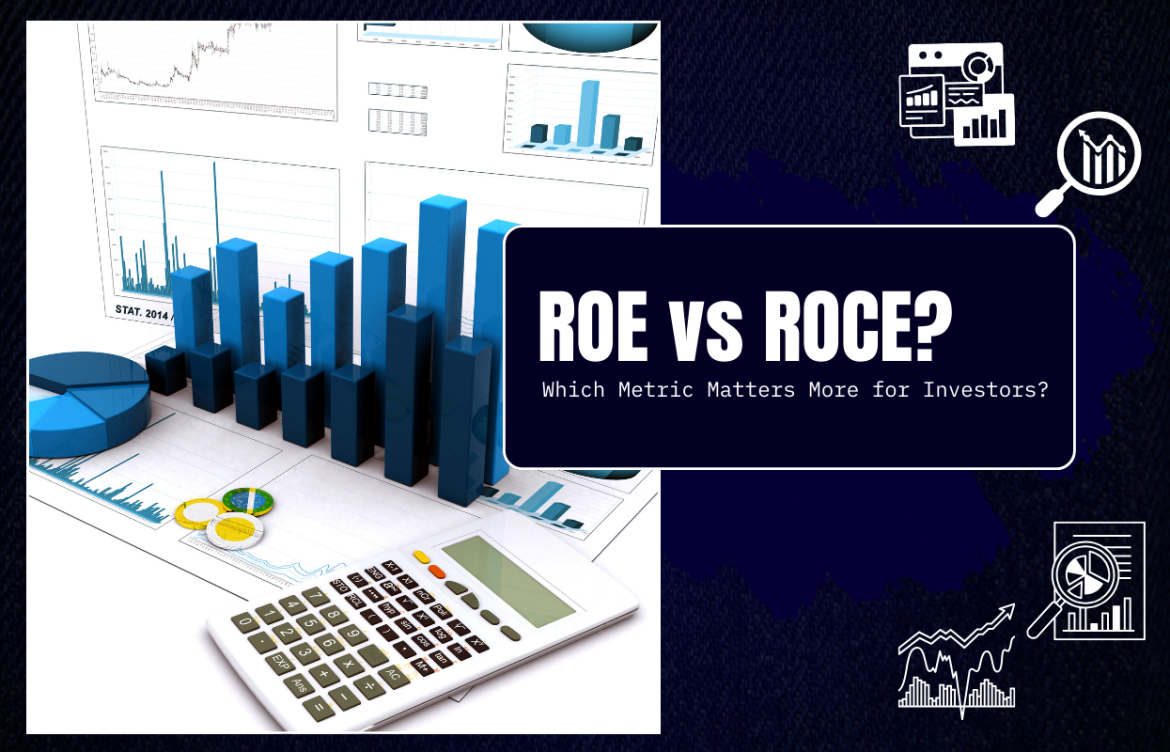
ROE vs ROCE: Which Metric Matters More for Investors?
ROE vs ROCE: Which Metric Matters More for Investors?
When evaluating a company for investment, one of the first questions investors ask is simple: How efficiently is this business generating returns?
Two of the most widely used metrics to answer this question are ROE (Return on Equity) and ROCE (Return on Capital Employed). Although they sound similar, they measure different aspects of business performance and can lead to very different conclusions if not interpreted correctly.
In this blog, we break down ROE vs ROCE in a clear, practical way so retail and emerging investors can confidently use them while evaluating stocks.
What Is ROE (Return on Equity)?
ROE measures how effectively a company generates profit from shareholders’ equity.
It tells investors whether the company is rewarding its owners (shareholders) with strong returns.
Formula:
ROE = Net Profit / Shareholders’ Equity
What ROE Tells You
-
How well management is using shareholder funds
-
Efficiency of internal reinvestment
-
Long-term value creation potential
When a High ROE Is Good
-
Business is cash-generative
-
Profits are growing sustainably
-
Low or manageable debt levels
When a High ROE Is a Red Flag
A very high ROE could also mean:
-
Extremely high debt reducing equity
-
One-time gains boosting net profit
-
Asset-light models with skewed capital structure
This is why ROE should never be looked at in isolation.
Example of ROE
Company A
-
Net Profit: ₹100 crore
-
Shareholder Equity: ₹500 crore
→ ROE = 100/500 = 20%
This means Company A generates a 20% return on every rupee of equity invested.
What Is ROCE (Return on Capital Employed)?
ROCE measures how efficiently a company uses all its capital—both equity and debt—to generate profit.
Formula:
ROCE = EBIT / Capital Employed
(where Capital Employed = Equity + Debt)
What ROCE Tells You
-
How effectively the company utilizes both equity and borrowed funds
-
Efficiency of expansion, manufacturing, and capital-intensive assets
-
Overall profitability and return on total capital
When a High ROCE Is Good
-
Company is efficiently turning capital into profit
-
Strong performance in competitive industries
-
Scalable business model with balanced leverage
When a Low ROCE Is a Warning
-
Inefficient asset usage
-
Poor capital allocation
-
High borrowing not leading to proportional returns
Example of ROCE
Company B
-
EBIT: ₹150 crore
-
Equity + Debt: ₹1,000 crore
→ ROCE = 150/1000 = 15%
This means Company B generates 15% return on all capital deployed.
ROE vs ROCE: What’s the Key Difference?
| Factor | ROE | ROCE |
|---|---|---|
| Measures | Return on shareholder equity | Return on total capital employed |
| Debt impact | High debt increases ROE | Includes debt → gives true capital efficiency |
| Suitable for | Asset-light, low-debt businesses | Capital-intensive businesses |
| Ideal use | Profitability for shareholders | Efficiency of entire business |
| Manipulation risk | Easily inflated by debt | Harder to manipulate |
Which Metric Should You Prioritize?
The short answer: Both matter—but for different reasons.
Use ROE When Evaluating:
-
Banks & financial institutions
-
IT services
-
Consumer brands
-
Asset-light businesses
-
Companies with low debt
Here, ROE gives a clear picture of shareholder returns.
Use ROCE When Evaluating:
-
Manufacturing companies
-
Automobiles
-
Cement, steel, infra
-
Energy companies
-
Telecom
-
Capital-heavy sectors
These businesses rely heavily on fixed assets and borrowed capital—making ROCE more meaningful.
The Most Reliable Approach: Compare ROE & ROCE Together
A powerful investor rule:
If ROE > ROCE → The company is using debt effectively.
…but check whether debt levels are safe.
If ROCE > ROE → The company has low debt or inefficient equity usage.
Worth checking capital allocation strategy.
If both ROE and ROCE are consistently high → This is a high-quality business.
Such companies often become multibaggers over the long term.
Real-Life Example: Applying ROE & ROCE Together
Company X (FMCG Company)
-
ROE: 25%
-
ROCE: 22%
-
Low debt
Interpretation:
Strong operational and capital efficiency → High-quality, stable compounder.
Company Y (Capital-Intensive Manufacturing Firm)
-
ROE: 28%
-
ROCE: 12%
-
High debt
Interpretation:
ROE is inflated due to heavy leverage → Higher risk → Dig deeper into debt servicing capacity.
How to Use These Metrics in Your Investment Process
1. Always Compare with Industry Peers
A 20% ROE is great in manufacturing, but average in banking.
Context matters.
2. Track 5–10 Year History
Consistent performance → Strong management & business model
Volatile performance → Higher risk
3. Avoid Companies with Very High ROE but Very Low ROCE
This suggests debt-driven returns, not sustainable growth.
4. Look for Companies with:
-
ROE > 15%
-
ROCE > 12%
-
Stable or improving over time
-
Moderate or low debt
These are often long-term wealth creators.
Final Thoughts
ROE and ROCE are among the most important tools in an investor’s toolkit.
Used correctly, they help identify:
-
Efficient capital allocators
-
Scalable business models
-
Strong long-term compounders
-
Businesses with stable profitability
But relying on one metric alone can be misleading. The smart approach is to study both ROE and ROCE in combination, compare with peers, and track their long-term trends.
Ultimately, companies that consistently maintain high ROE + high ROCE + low debt tend to deliver superior stock market returns over time.
Related Blogs:
What Is Fundamental Analysis? A Beginner’s Guide
How to Read a Company’s Balance Sheet Before Investing
Understanding the Income Statement: A Beginner’s Guide
Understanding Cash Flow Statements for Investors
Secrets of Smart Money: How FII & DII Data Reveal Market Direction
How to Analyze Management Quality Using Publicly Available Data
Disclaimer: This blog post is intended for informational purposes only and should not be considered financial advice. The financial data presented is subject to change over time, and the securities mentioned are examples only and do not constitute investment recommendations. Always conduct thorough research and consult with a qualified financial advisor before making any investment decisions.

